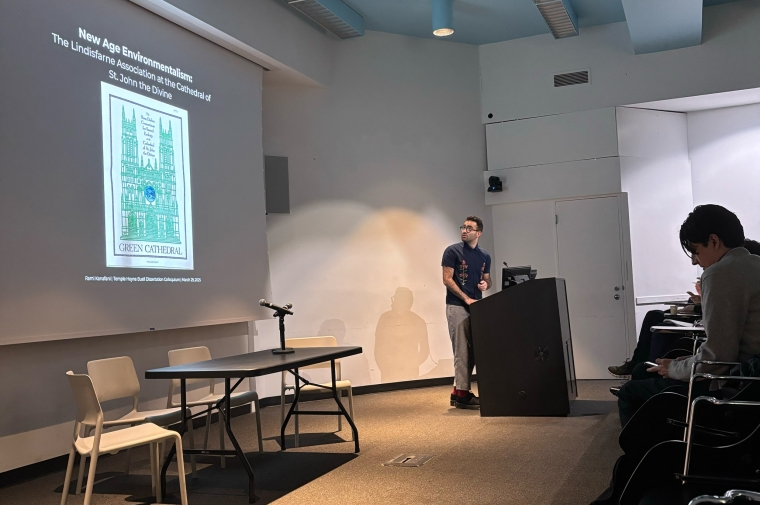April 10, 2019
Stuart Weitzman School of Design
102 Meyerson Hall
210 South 34th Street
Philadelphia, PA 19104
Get the latest Weitzman news in your Inbox
Areas
“In the best of circumstances,” says Franca Trubiano, associate professor of architecture at the University of Pennsylvania Stuart Weitzman School of Design, “we have a balance between a theory that speaks about architecture and one that speaks beyond it.”
Throughout the last few decades of the 20th century, as a range of disciplines in American universities immersed themselves in conversations about postmodernism and poststructuralism, theory had an outsized role in the education and practice of architecture, says Trubiano. Since roughly the turn of the century, though, two important changes have occurred, she says. A number of architecture journals have stopped publishing, depriving the field of a critical venue for theoretical work. And digital innovation has transformed the practice of design, capturing the attention of young architects.
“And what has happened is that progressively more of the architect’s education has been focused on technique and on production,” Trubiano says. “Less has been focused on a reflection on what that means.”
In early April, in an effort to restore some balance to the scales, Trubiano helped organize a two-day conference in Meyerson Hall in which architects and scholars from around the globe responded to the question, “What has happened to architectural theory and where is it headed?” The conference, titled Architectural Theory Now?,was co-organized by Trubiano, Professor of Architecture David Leatherbarrow, and Peter Laurence, associate professor of architecture in the College of Architecture, Arts and Humanities at Clemson University.
At an all-day series of paper sessions and keynote conversations in Lower Gallery on Friday, April 5, participants returned again and again to questions of theory’s purpose: To what degree should architectural theory refine the practice of architecture and to what degree should it push past practice and engage with larger theoretical problems?
In the first paper session, called Within/Without, panelists grappled with ideas about theory’s relationship to building, and architecture’s connection to other disciplines.
“What and who is within or without architecture?” asked Rebecca Williamson, associate professor of architecture at the University of Cincinnati. “It’s a question that one could ask about any discipline, and a droll one for a field so intent on producing insides and defining outsides.”
Williamson read from her paper, “Theory Calls out from the Rubble.” Other presenters in the first Friday session included Juan Manuel Heredia, Associate Professor of Architecture at Portland State University, who presented a paper called “Architecture is its Own Theory;” Lynnette Widder, Lecturer in the Discipline of Sustainability Management at Columbia University, reading from “The Theory of Architecture in Year Zero: the Darmstädter Gespräch of 1951;” and Andreea Mihalache, assistant professor of architecture at Clemson, presenting “On “Deferred Judgment:” Historical and Contemporary Perspectives.”
The papers were solicited through an international call for abstracts, Trubiano says, and selected through a blind peer-review process. Other participants in the keynote conversations were invited to present.
The second paper session, on Practices, was focused on “contemporary practices of architectural theory as defined through the lens of writers, philosophers, and theorists.” Moderated by Trubiano, it featured papers from Jon Yoder, associate professor of architecture at Kent State University; Ufuk Ersoy, associate professor of architecture at Clemson; and Ellen Grimes, associate professor of architecture at the School of the Art Institute of Chicago.
In her presentation, “No Future for the Recent Past: Architectural Theory After Sustainability,” Grimes argued that criticizing “sustainability” is easy, but find a principle to replace it is difficult. In 2008, Grimes was awarded a fellowship to create an ecological infrastructure plan for Midewin National Tallgrass Prairie, a brownfield outside Chicago. The project “failed,” Grimes said, in ways that illuminate the limits of theories of sustainability.
“My hope is that architectural theory can take on the task of asserting new logic for sustainability and offer something like an eco-logic, a way of knowing change with design practice,” Grimes said.
“New logics” are required to shape architectural and landscape practice in ways that respond to contemporary ecological challenges, she said.
“At Midewin,” Grimes said, “the ecologists and the forest rangers understood the prairie restoration through two similar but distinct modernist systems—conservation and evolution. The problem wasn't just that the systems came into conflict, which they did. It was that we weren't able to find a logic for the project, for negotiating the politics of each idea of nature constructed by these two systems.”
The third paper session, Re-Definitions, was moderated by Sophie Debiasi Hochhäusl, an assistant professor of architecture at the Weitzman School, and was focused on “expanding the definition of architectural theory by introducing and discussing alternative methods, practices, and values.” It featured papers from Jonathan Hale, professor of architectural theory at the University of Nottingham; Christian Parreno, assistant professor of history and theory of architecture at Universidad San Francisco de Quito, Ecuador; and Terrance Galvin, founding director of Laurentian University’s McEwen School of Architecture.
To cap off the conference, Joan Ockman, a senior lecturer in architecture at the Weitzman School, offered a set of arguments for the centrality of theory, and re-definition of her own. “Disciplines sustain themselves in an through theory,” Ockman argued. Theories are products of their time—redefined in relation to the world they reflect on. Given the transformations of the last three decades, architectural theory too must be transformed, she said. Theory’s primary task is “to help architects understand their role and responsibility in a globalized world facing unprecedented social, political, economic, technological, and environmental challenges.” And it is urgent “to re-imagine the future: To redefine theory from critical negativity to hope—without letting go of critical negativity.”
“Paradoxically,” Ockman said, “in an age overwhelmed by images, theory can be redefined as a powerful way of seeing things: theory as a mode of beholding, a form of witness.”
Read the entire program here.


 View Slideshow
View Slideshow



